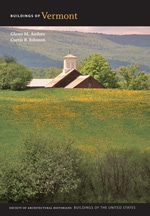
This striking little church was built as part of an orderly workers' village adjacent to a paper mill on the Connecticut River. The Fitzgerald (see ES6) and Dale families of Island Pond founded the mill in the 1880s, and the community that grew around it was known as Fitz-dale until Isaac Gilman of New York acquired the mill in 1915. During the 1920s Gilman provided housing, a water system, and street lighting, and assisted in developing for his workers a school, stores, hotel, restaurants, railroad station, community hall, post office, hospital, and two Christian churches (though he himself was Jewish). Of these last, St. Theresa's is unpretentious in size and materials but carefully designed and detailed. Built by local carpenter Conrad, it presents a sophisticated mix of Gothic, Tudor, and Craftsman traditions. Its simple gabled rectangular body has a gabled entrance vestibule at one end and a vestry at the other. The flared, wood-shingled walls are organized by buttresses between clustered square-headed windows with small divided lights below transom panels. Historicizing decorative touches are provided by iron strap hinges on the doors, half timbering in the gables, and a shingled belfry with trilobed arches and tall flaring spire set diagonally atop the roof ridge at the end of the nave. The pews are reputed to have come from a church in North Concord.

